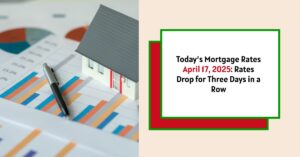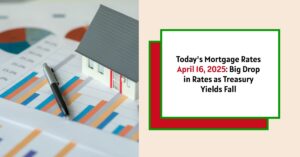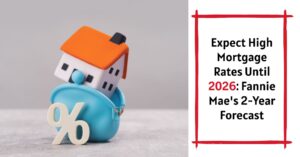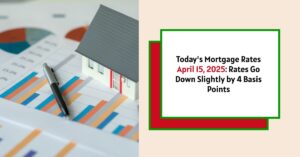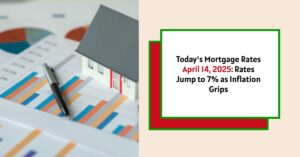Mortgage rates today, April 19, 2025, have increased, reflecting market responses to economic indicators. The average 30-year fixed mortgage rate is now 6.79%, while the 15-year fixed rate has climbed to 6.11%. These upticks follow recent comments from Federal Reserve Chair Jerome Powell, which have led to market reactions in anticipation of economic effects. Understanding these shifts in mortgage rates is crucial for both homebuyers and homeowners considering refinancing, as they can significantly affect borrowing costs and overall financial health.
Mortgage Rates Today, April 19, 2025, Surge After Powell's Statement
Key Takeaways
- Mortgage Rates Increased: After a week of drops, rates rose due to economic comments from the Fed.
- Current Rates: The average 30-year fixed rate is 6.79%, and the 15-year fixed is 6.11%.
- Refinance Rates Higher: Mortgage refinance rates also saw a rise today.
- Influence of Federal Reserve: Powell's remarks about interest rates and tariffs hint at ongoing economic changes.
Understanding Today's Mortgage Rates
Mortgage rates are significant because they determine how much interest homeowners will pay over the life of their loan. The current rise in these rates is influenced by multiple factors, primarily economic policies and market expectations. Here’s a breakdown of the current rates according to Zillow:
| Mortgage Type | Current Rate |
|---|---|
| 30-year Fixed | 6.79% |
| 20-year Fixed | 6.66% |
| 15-year Fixed | 6.11% |
| 5/1 ARM | 6.99% |
| 7/1 ARM | 7.41% |
| 30-year VA | 6.33% |
| 15-year VA | 6.01% |
| 5/1 VA | 6.31% |
Current Mortgage Refinance Rates
For homeowners looking to refinance, here are the current refinance rates:
| Refinance Type | Current Rate |
|---|---|
| 30-year Fixed | 6.83% |
| 20-year Fixed | 6.46% |
| 15-year Fixed | 6.22% |
| 5/1 ARM | 6.53% |
| 7/1 ARM | 6.99% |
| 30-year VA | 6.40% |
| 15-year VA | 6.16% |
| 5/1 VA | 6.36% |
Note: These rates are national averages rounded to the nearest hundredth.
The Impact of Federal Reserve Policies
Jerome Powell's recent remarks indicate that the Federal Reserve is not planning to cut interest rates to support the stock market, particularly considering that inflation and economic growth are showing signs of turbulence. Powell declared that the increase in tariffs imposed suggested a temporary rise in inflation.
Higher inflation generally results in increased mortgage rates, as lenders adjust their expectations of future economic conditions. Investors might demand higher returns on mortgage-backed securities if they believe inflation will continue to rise, leading to higher mortgage costs for consumers.
What This Means for Homebuyers and Homeowners
For potential homebuyers, rising mortgage rates may complicate the affordability landscape. Higher rates typically lead to increased monthly payments. For example, on a $300,000 mortgage at the current 30-year fixed rate of 6.79%, the monthly principal and interest payment would be approximately $1,950. If the rate were to increase further, payments would rise accordingly, making homeownership less accessible.
Homeowners considering refinancing might also feel the pressure of these increasing rates. While refinancing can often lower monthly payments or adjust loan terms to better fit one's financial situation, the current uptick in rates could negate the benefits in many cases unless substantial savings are present.
Read More:
Mortgage Rates Trends as of April 18, 2025
Mortgage Rate Predictions for This Week: Expect Volatility, Not Relief
Mortgage Rates Likely to Go Down in the Short Term Due to Tariffs
Understanding Fixed vs. Adjustable Rates
Fixed-rate mortgages lock in your interest rate for the life of the loan, providing predictability in monthly payments. In contrast, adjustable-rate mortgages (ARMs) usually offer lower initial rates, which can later fluctuate. For instance:
- 5/1 ARM starts at a lower rate (currently 6.99%) fixed for the first five years but may adjust yearly after that.
- 15-year fixed offers a lower interest rate (currently 6.11%) but results in higher monthly payments due to the shorter repayment term.
Each option has its respective advantages and disadvantages, and understanding personal financial situations is crucial in making the best choice.
Factors Influencing Future Mortgage Rates
Several factors could influence future mortgage rates:
- Inflationary Pressures: If inflation continues to rise significantly, mortgage rates are likely to rise as well.
- Economic Growth: Slow economic growth could compel the Fed to reconsider its policies, potentially leading to rate cuts if the economy weakens significantly.
- Labor Market Indicators: A weakening job market could also persuade the Fed to shift its approach, impacting mortgage rates.
Is Now a Good Time to Buy a House?
Whether now is a good time to purchase a property essentially depends on individual circumstances and readiness. While home prices are not spiking as they did during pandemic highs, higher mortgage rates mean it's essential to evaluate long-term financial capabilities versus current selling prices.
The current market provides an opportunity for buyers to negotiate better terms and pricing without significant competition compared to previous years. However, the unpredictability of interest rates should make buyers cautious. Home seekers should prioritize personal financial stability over attempting to time the market.
Frequently Asked Questions (FAQs)
1. What influences mortgage rates? Mortgage rates are influenced by several factors, including federal monetary policy, inflation rates, and overall economic conditions. The supply and demand for mortgage-backed securities also play a critical role.
2. Are current mortgage rates higher than last year? Yes, current mortgage rates are generally higher compared to the same time last year, reflecting rising inflation and shifts in the Federal Reserve's policy.
3. What is the difference between fixed-rate and adjustable-rate mortgages? Fixed-rate mortgages maintain the same interest rate over the life of the loan, offering stability. Adjustable-rate mortgages have lower initial rates that reset after a specified period, which can lead to fluctuations in monthly payments.
4. Should I refinance my mortgage now? Deciding whether to refinance should depend on the current rate environment and your financial situation. With rates on the rise, refinancing might not always yield savings unless it significantly reduces your rate compared to your current mortgage.
5. How can I lock in a low mortgage rate? You can typically lock in a mortgage rate through your lender once you have a purchase agreement. This guarantees your rate for a limited time while you complete the loan process.
The Broader Implications of Mortgage Rates on the Economy
The state of mortgage rates significantly influences the housing market and, by extension, the overall economy. Higher mortgage rates often lead to reduced home sales, affecting related sectors such as construction, home goods, and real estate services. If the trend of increasing rates continues, it could potentially cool down housing market activity or slow new home starts.
Furthermore, consumer sentiment toward the economy generally shifts with fluctuations in mortgage rates. As potential buyers face higher borrowing costs, their confidence in entering the housing market may wane, contributing to slower economic growth in the affected sectors.
Work With Norada, Your Trusted Source for
Real Estate Investment in the U.S.
Investing in turnkey real estate can help you secure consistent returns with fluctuating mortgage rates.
Expand your portfolio confidently, even in a shifting interest rate environment.
Speak with our expert investment counselors (No Obligation):
(800) 611-3060
Also Read:
- Will Mortgage Rates Go Down in 2025: Morgan Stanley's Forecast
- Expect High Mortgage Rates Until 2026: Fannie Mae's 2-Year Forecast
- Mortgage Rate Predictions 2025 from 4 Leading Housing Experts
- Mortgage Rates Forecast for the Next 3 Years: 2025 to 2027
- 30-Year Mortgage Rate Forecast for the Next 5 Years
- 15-Year Mortgage Rate Forecast for the Next 5 Years
- Why Are Mortgage Rates Going Up in 2025: Will Rates Drop?
- Why Are Mortgage Rates So High and Predictions for 2025
- Will Mortgage Rates Ever Be 3% Again in the Future?
- Mortgage Rates Predictions for Next 2 Years
- Mortgage Rate Predictions for Next 5 Years
- Mortgage Rate Predictions: Why 2% and 3% Rates are Out of Reach
- How Lower Mortgage Rates Can Save You Thousands?
- How to Get a Low Mortgage Interest Rate?
- Will Mortgage Rates Ever Be 4% Again?



